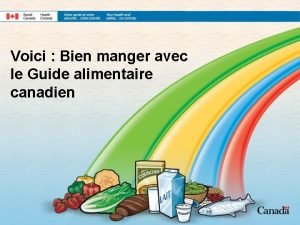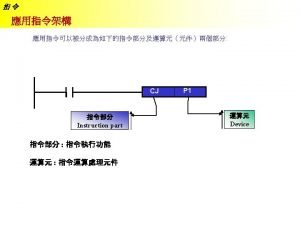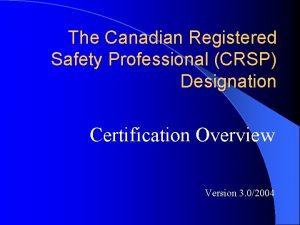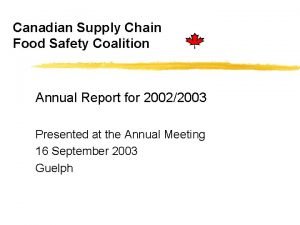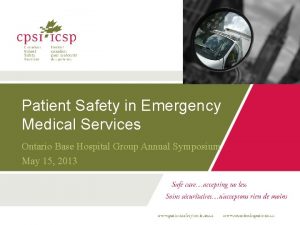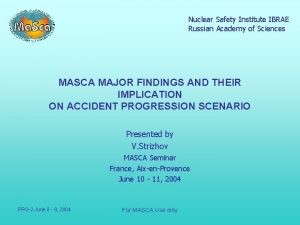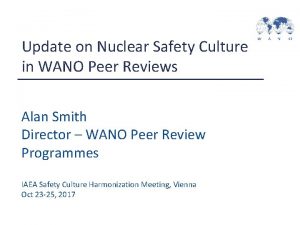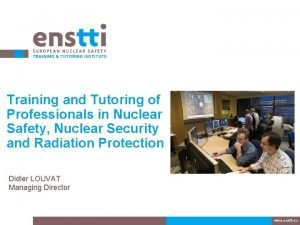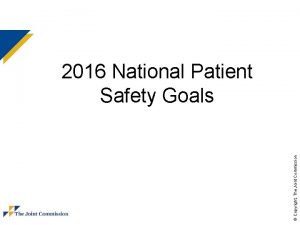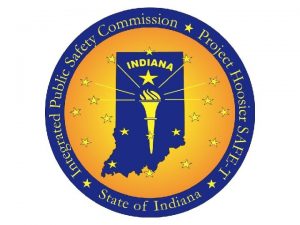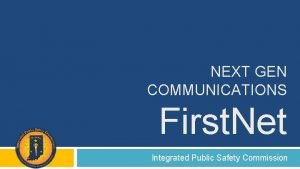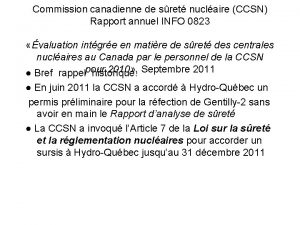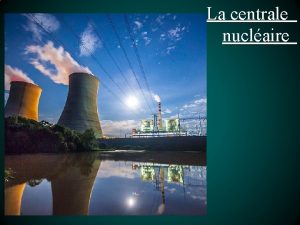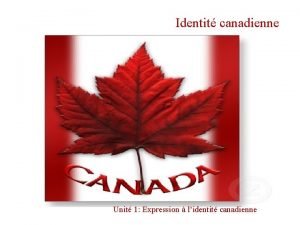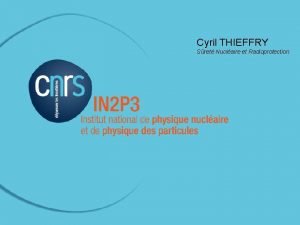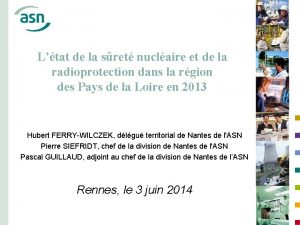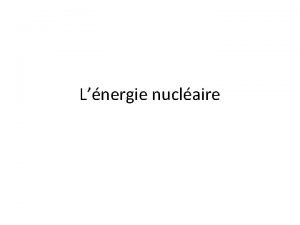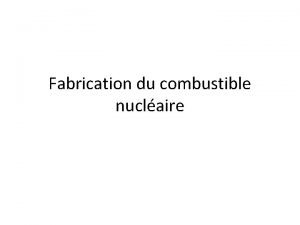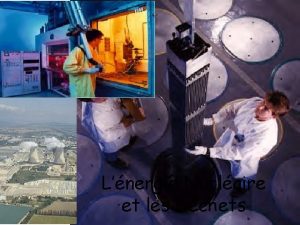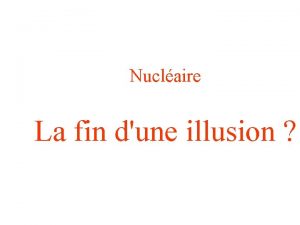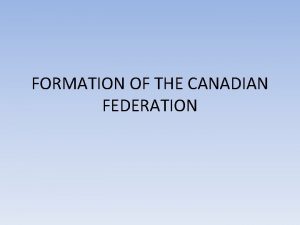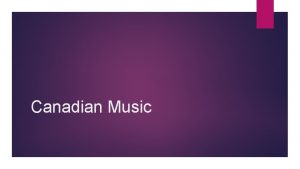Canadian Nuclear Safety Commission canadienne de sret nuclaire


















- Slides: 18

Canadian Nuclear Safety Commission canadienne de sûreté nucléaire Conducting an Industrial Radiography Field Inspection – Canadian Overview September 2017 e-Docs #5339998 PPTX nuclearsafety. gc. ca

Content • Introduction • Regulatory Expectations • Conclusion

Introduction • Focus on regulatory expectations when conducting a radiography field inspection. • Just a perception of what we look for in Canada

NSRD 30 – Obligations of Licensees • • Appropriate and calibrated dosimetry Calibrated radiation detection equipment A safe and properly functioning device Well maintained accessory equipment Emergency Equipment Signage and Barriers Trained workers Please note – this is not a comprehensive list

NSRD 31 – Obligations of Operators • • • Properly worn dosimetry Use of a calibrated Survey Meter Immediate availability of emergency equipment DRD Readings and Pre-Op Checks Placement of signs, barriers and persons Locking of device while not in operation Please note – this is not a comprehensive list

NSRD 31(6) – Emergency Situations • Source retrieval requires specialized training • Know your company’s response procedure • FOLLOW THIS PROCEDURE

Field Documents • • Valid CNSC Licence Transport Document TDG Certificate Radiation Safety Manual Device Operating Procedures Emergency Response Procedures CEDO Cards – highly recommended, but may soon be required.

Required Equipment • Survey Meters – How many depends on what is in your company’s procedures • Dosimetry – TLD/OSLD, DRD, PAD • Emergency Equipment – Tunnel, Cutters, Tongs • Signage and Barriers – Condition and Placement

Security • Overnight storage, unattended vehicle or return to the shop? • What security is required for your situation? • Know how to properly arm and disarm your system • Know what features your system has – GPS, FOB, etc • System condition – Bad contacts and loose wires

CEDO Expectations (Knowledge) • • • Operator Obligations Company Procedures Signage and Area Control Emergency Procedures No-Go Gauge Checks Teleflex Flex-test – we do expect to see this.

Operations – Survey Meter Use • NSRD 31(1)(h) -after each attempt to move the sealed source assembly to the shielded position inside the exposure device, use a radiation survey meter to determine that the sealed source assembly is in the shielded position • Question: Does my survey method meet the intent of this regulation?

Operations – The Device • • Legible labels Consignor ID Source ID Tag Field ID Guide Tubes Cranks General Condition

Operations – Signs and Barriers • Signs – posted at 25 u. Sv/hr (2. 5 m. R/hr) • Barriers – erected at 100 u. Sv/hr (10 m. R/hr) Questions: Can I see the entire radiography area? Can I control the area? It is the Operator’s responsibility to ensure the area is properly controlled

Operations - Transport 4 Class-7 Placards Transport Document within Driver’s Reach Device securely stowed PTNS 28(2) Exception: Certified device, one consignor only, 4 Class-7 placards • Words “Exclusive Use” can no longer be used. • •

Operation – Dose to the Public • NSRD 30(6) and NSRD 31(1)(i): 0. 1 m. Sv per week and 0. 5 m. Sv per year. • CNSC Inspectors may ask for documented evidence that you are in compliance with these regulations. • What may raise our concerns? - Unexpected dose rates - Near-by occupied buildings - Reports from the Public

Conclusion CNSC Expectations • Adherence to the Act and the Regulations • Adherence to your company’s policies and procedures • Safe and Responsible use of Nuclear Substances Field Inspections help the CNSC evaluate the adherence & effectiveness of a licensee's program.

Questions

Thank you Canadian Nuclear Safety Commission www. nuclearsafety. gc. ca Facebook. com/Canadian. Nuclear. Safety. Commission Youtube. ca/cnscccsn Twitter. com@CNSC_CCSN September 2017 e-Docs #5339998 PPTX
 Pyramide alimentaire canadienne
Pyramide alimentaire canadienne Asci hex
Asci hex Pyramide alimentaire canadienne
Pyramide alimentaire canadienne Lesson 15 nuclear quest nuclear reactions
Lesson 15 nuclear quest nuclear reactions Fisión nuclear vs fision nuclear
Fisión nuclear vs fision nuclear Canadian tourism commission
Canadian tourism commission Crsp designation
Crsp designation Canadian supply chain food safety coalition
Canadian supply chain food safety coalition Canadian patient safety officer course
Canadian patient safety officer course Canada motor vehicle safety regulations
Canada motor vehicle safety regulations Mudaliar commission year
Mudaliar commission year Graduated commission in a sentence
Graduated commission in a sentence Nuclear safety institute of the russian academy of sciences
Nuclear safety institute of the russian academy of sciences Nuclear safety culture
Nuclear safety culture Nuclear safety training
Nuclear safety training National safety goals 2016
National safety goals 2016 Integrated public safety commission
Integrated public safety commission Integrated public safety commission
Integrated public safety commission Ecdis safety settings
Ecdis safety settings
